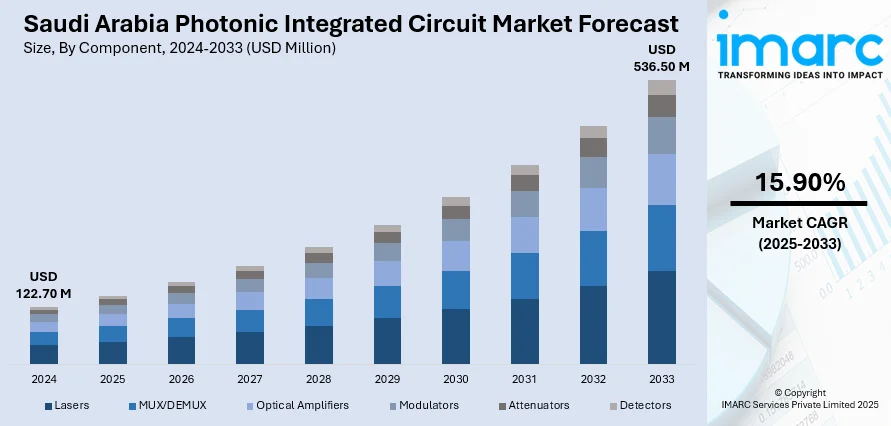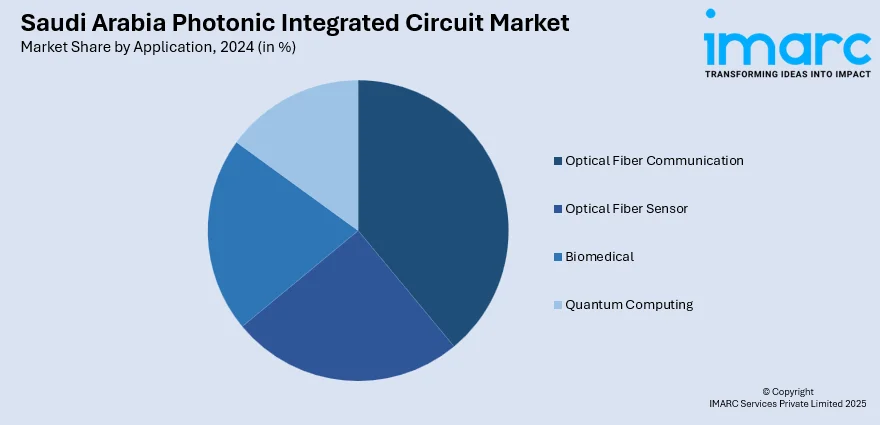
Saudi Arabia Photonic Integrated Circuit Market Size, Share, Trends and Forecast by Component, Raw Material, Integration, Application, and Region, 2025-2033
Saudi Arabia Photonic Integrated Circuit Market Overview:
The Saudi Arabia photonic integrated circuit market size reached USD 122.70 Million in 2024. Looking forward, IMARC Group expects the market to reach USD 536.50 Million by 2033, exhibiting a growth rate (CAGR) of 15.90% during 2025-2033. The market is growing rapidly due to rising investments in 5G, data centers, and optical communication infrastructures. Besides this, government-backed digital transformation initiatives and increasing demand for high-speed, energy-efficient technologies across the defense, healthcare, and telecommunications sectors are further propelling the adoption of photonic integrated circuits (PICs) across the country.
|
Report Attribute
|
Key Statistics
|
|---|---|
|
Base Year
|
2024 |
|
Forecast Years
|
2025-2033
|
|
Historical Years
|
2019-2024
|
| Market Size in 2024 | USD 122.70 Million |
| Market Forecast in 2033 | USD 536.50 Million |
| Market Growth Rate 2025-2033 | 15.90% |
Saudi Arabia Photonic Integrated Circuit Market Trends:
Expansion of High-Speed Data Infrastructure
Saudi Arabia’s Vision 2030 has significantly accelerated its digital transformation, driving substantial investments in telecommunications and data center infrastructure. This rapid development is fueling the adoption of PICs, which are crucial for enabling high-speed and low-latency data transmission. The Kingdom has made rapid progress in 5G deployment, achieving 77% nationwide coverage and 94% in Riyadh, thereby necessitating advanced optical technologies like PICs to meet growing connectivity demands. In parallel, the data center market in Saudi Arabia reached USD 2.1 billion in 2024 and is projected to expand to USD 7.7 billion by 2033, registering a CAGR of 15.6% from 2025 to 2033. Supporting this expansion, companies are expanding their own investments. For example, Alfanar Global Development has announced a USD 1.4 billion investment to establish four new data centers. Furthermore, the integration of silicon photonics, which combines optical components with silicon-based electronics, is gaining traction, resulting in quicker data transfer and lower energy usage. These accomplishments strengthen Saudi Arabia's status as a regional leader in photonics and a center for technical innovation.

Integration of PICs in Healthcare and Smart City Applications
PICs are becoming increasingly important in Saudi Arabia's healthcare and smart city programs, which line closely with the country's Vision 2030 goals. In healthcare, PICs improve medical diagnoses by analyzing data in real time and with great precision, thereby improving patient outcomes. Notably, researchers from King Abdullah University of Science and Technology (KAUST) have created silicon photonics-based biosensors that can detect numerous biomarkers at once, considerably improving early illness detection capabilities. In addition to this, Saudi Arabia’s efforts to develop smart cities are gaining global recognition, with five cities ranking among the world’s top 100 smart cities in 2024, Riyadh leading domestically at 25th place and Al-Khobar ranked 99th globally. PICs are essential to these developments, supporting sophisticated communication systems and efficient data management within urban infrastructure. Moreover, as the Internet of Things (IoT) ecosystem expands, PICs enable the high-speed, reliable communication networks required for seamless smart city functionality.
Saudi Arabia Photonic Integrated Circuit Market Segmentation:
IMARC Group provides an analysis of the key trends in each segment of the market, along with forecasts at the region/country level for 2025-2033. Our report has categorized the market based on component, raw material, integration, and application.
Component Insights:
- Lasers
- MUX/DEMUX
- Optical Amplifiers
- Modulators
- Attenuators
- Detectors
The report has provided a detailed breakup and analysis of the market based on the component. This includes lasers, MUX/DEMUX, optical amplifiers, modulators, attenuators, and detectors.
Raw Material Insights:
- Indium Phosphide (InP)
- Gallium Arsenide (GaAs)
- Lithium Niobate (LiNbO3)
- Silicon
- Silica-on-Silicon
A detailed breakup and analysis of the market based on the raw material have also been provided in the report. This includes indium phosphide (InP), gallium arsenide (GaAs), lithium niobate (LiNbO3), silicon, and silica-on-silicon.
Integration Insights:
- Monolithic Integration
- Hybrid Integration
- Module Integration
The report has provided a detailed breakup and analysis of the market based on the integration. This includes monolithic integration, hybrid integration, and module integration.
Application Insights:

- Optical Fiber Communication
- Optical Fiber Sensor
- Biomedical
- Quantum Computing
A detailed breakup and analysis of the market based on the application have also been provided in the report. This includes optical fiber communication, optical fiber sensor, biomedical, and quantum computing.
Regional Insights:
- Northern and Central Region
- Western Region
- Eastern Region
- Southern Region
The report has also provided a comprehensive analysis of all the major regional markets, which include Northern and Central Region, Western Region, Eastern Region, and Southern Region.
Competitive Landscape:
The market research report has also provided a comprehensive analysis of the competitive landscape. Competitive analysis such as market structure, key player positioning, top winning strategies, competitive dashboard, and company evaluation quadrant has been covered in the report. Also, detailed profiles of all major companies have been provided.
Saudi Arabia Photonic Integrated Circuit Market News:
- February 2025: Groq, a US AI chip startup, secured a USD 1.5 billion commitment from Saudi Arabia to expand its data center and advance AI chip delivery across the country. This expansion, focusing on fast AI inference and large language models, is expected to drive the need for PICs to optimize data processing speed and efficiency in AI technologies, contributing to the growing demand in the semiconductor sector.
- June 2024: Saudi Arabia launched the National Semiconductor Hub with a USD 266 million fund, aiming to become a major player in the semiconductor industry. This initiative is expected to drive demand for PICs as part of the Kingdom's focus on semiconductor design. By 2030, the hub plans to attract 50 companies, advancing innovation in PIC technology to support global growth.
Saudi Arabia Photonic Integrated Circuit Market Report Coverage:
| Report Features | Details |
|---|---|
| Base Year of the Analysis | 2024 |
| Historical Period | 2019-2024 |
| Forecast Period | 2025-2033 |
| Units | Million USD |
| Scope of the Report |
Exploration of Historical Trends and Market Outlook, Industry Catalysts and Challenges, Segment-Wise Historical and Future Market Assessment:
|
| Components Covered | Lasers, MUX/DEMUX, Optical Amplifiers, Modulators, Attenuators, Detectors |
| Raw Materials Covered | Indium Phosphide (InP), Gallium Arsenide (GaAs), Lithium Niobate (LiNbO3), Silicon, Silica-on-Silicon |
| Integrations Covered | Monolithic Integration, Hybrid Integration, Module Integration |
| Applications Covered | Optical Fiber Communication, Optical Fiber Sensor, Biomedical, Quantum Computing |
| Regions Covered | Northern and Central Region, Western Region, Eastern Region, Southern Region |
| Customization Scope | 10% Free Customization |
| Post-Sale Analyst Support | 10-12 Weeks |
| Delivery Format | PDF and Excel through Email (We can also provide the editable version of the report in PPT/Word format on special request) |
Key Questions Answered in This Report:
- How has the Saudi Arabia photonic integrated circuit market performed so far and how will it perform in the coming years?
- What is the breakup of the Saudi Arabia photonic integrated circuit market on the basis of component?
- What is the breakup of the Saudi Arabia photonic integrated circuit market on the basis of raw material?
- What is the breakup of the Saudi Arabia photonic integrated circuit market on the basis of integration?
- What is the breakup of the Saudi Arabia photonic integrated circuit market on the basis of application?
- What are the various stages in the value chain of the Saudi Arabia photonic integrated circuit market?
- What are the key driving factors and challenges in the Saudi Arabia photonic integrated circuit market?
- What is the structure of the Saudi Arabia photonic integrated circuit market and who are the key players?
- What is the degree of competition in the Saudi Arabia photonic integrated circuit market?
Key Benefits for Stakeholders:
- IMARC’s industry report offers a comprehensive quantitative analysis of various market segments, historical and current market trends, market forecasts, and dynamics of the Saudi Arabia photonic integrated circuit market from 2019-2033.
- The research report provides the latest information on the market drivers, challenges, and opportunities in the Saudi Arabia photonic integrated circuit market.
- Porter's five forces analysis assist stakeholders in assessing the impact of new entrants, competitive rivalry, supplier power, buyer power, and the threat of substitution. It helps stakeholders to analyze the level of competition within the Saudi Arabia photonic integrated circuit industry and its attractiveness.
- Competitive landscape allows stakeholders to understand their competitive environment and provides an insight into the current positions of key players in the market.
Need more help?
- Speak to our experienced analysts for insights on the current market scenarios.
- Include additional segments and countries to customize the report as per your requirement.
- Gain an unparalleled competitive advantage in your domain by understanding how to utilize the report and positively impacting your operations and revenue.
- For further assistance, please connect with our analysts.
 Request Customization
Request Customization
 Speak to an Analyst
Speak to an Analyst
 Request Brochure
Request Brochure
 Inquire Before Buying
Inquire Before Buying




.webp)




.webp)












